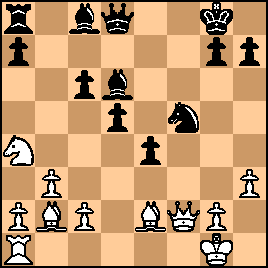Apr-16-10
 | | An Englishman: Good Evening: Another forgotten 19th Century player of possible GM strength, Lipke seems to have had quite a talent for sudden attacks, such as in this game. |
|
| Aug-05-22 | | Brenin: By move 16 White had ceded the centre and the initiative to his opponent. Even so, 16 ... Ng4 must have come as a shock. The N cannot be taken, as 17 hxg4 allows 17 ... Qh4 18 g3 Bxg3 19 fxg3 Qxg3+ and 21 ... Rf2. |
|
| Aug-05-22 | | jrredfield: I didn't see 16 ...Ng4, but I did some analysis and determined that had White captured the N, Black would have been able to mate in 12 moves. |
|
| Aug-05-22 | | mel gibson: It took me over 30 seconds to choose the correct first ply. Stockfish 15 says:
16... Ng4
(16. .. Ng4 (♘f6-g4 ♖e1-e2 ♕d8-g5 ♕d1-d4 ♘g4-e5
♔g1-h1 ♖f8-f6 ♕d4-e3 ♕g5-h5 f2-f4 e4xf3/ep ♗b2xe5 f3xe2 ♗e5xf6 e2xf1♖+
♖a1xf1 g7xf6 ♖f1xf6 ♕h5-d1+ ♕e3-g1 ♕d1xg1+ ♔h1xg1 ♗d6-e5 ♖f6-f3 ♗e5-d4+
♔g1-h2 ♗c8-e6 g2-g4 ♖a8-e8 ♔h2-g3 ♗e6-f7 c2-c3 ♗d4-e5+ ♔g3-f2 ♖e8-e7 ♖f3-e3
d5-d4 ♖e3xe5 ♖e7xe5 c3xd4 ♖e5-e4 ♘a4-c3 ♖e4-f4+ ♔f2-e3 ♖f4-f1 ♔e3-e4
♖f1-e1+ ♔e4-f5 a7-a5 ♘c3-a4 ♖e1-e2 ♔f5-f6 ♖e2xa2 ♘a4-c5 ♖a2-f2+ ♔f6-e7
♖f2-f3 ♘c5-b7 ♖f3-e3+ ♔e7-f6 ♗f7xb3) +7.23/45 385) score for Black +7.23 depth 45. |
|
| Aug-05-22 | | newzild: Quite a lot easier than yesterday. |
|
| Aug-05-22 | | Granny O Doul: Preminiscent of that Capa-Marshall game, ...Ng4. |
|
| Aug-05-22 | | agb2002: The first idea that comes to mind is 16... Ng4, threatening 17... Bh2+ 18.Kh1 Nxf2+, 17... Nxf2, 17... Qh4, etc.: A) 17.hxg4 Qh4 (17... Bh2+ 18.Kxh2 Qh4+ 19.Kg1 Qxf2+ 20.Kh1 only seems to achieve perpetual check) A.1) 18.g3 Bxg3 wins (19.fxg3 Qxg3+ followed by Rf2; 19.Bg2 Qh2+ 20.Kf1 Rxf2#). A.2) 18.Be2 Qh2+ 19.Kf1 Qh1#.
A.3) 18.Bc4 Qxf2+ 19.Kh1(2) Qh4+ 20.Kg1 Qh2#.
A.4) 18.f4 exf3 wins.
B) 17.Bd4 Qh4
B.1) 18.hxg4 Qh2#.
B.2) 18.g3 Bxg3 wins (19.fxg3 Qxg3+ and mate next). B.3) 18.Qd2 Nxf2
B.3.a) 19.Bxf2 Rxf2 looks winning (20.Qxf2 Bh2+ and 21... Qxf2 wins decisive material). B.3.b) 19.Re2 Ng4 wins a pawn and threatens Qg3. B.4) 18.Re2 Nh2
B.4.a) 19.g3 Nf3+ 20.Kh1 (20.Kg2 Qxh3#) 20... Bxg3 is winning (21.fxg3 Qxg3 22.Rg2 Qxh3+ 23.Rh2 Qxh2#). B.4.b) 19.Qd2 Bxh3 is winning (20.gxh3 Nf3+).
C) 17.Re2 Qh4
C.1) 18.Bd4 Nh2 transposes to B.4.
C.2) 18.g3 Bxg3 19.fxg3 Qxg3+ 20.Rg2 (20.Bg2 Qh2#; 20.Kh1 Rf2 and mate in two) 20... Qe3+ 21.Kh1 Qxh3+ 22.Kg1 Qe3+ 23.Kh1 Nf2+ 24.Rxf2 Rxf2 is winning (25.Bg2 Bh3). |
|
| Aug-05-22 | | agb2002: I forgot Black's main threat after 17.Re2, probably due to the inertia generated by the many lines with 17... Qh4. |
|
| Aug-05-22 | | goodevans: <newzild: Quite a lot easier than yesterday.> To start with, yes.
<16... Ng4> - Obvious that the N can't be taken and the threat of 17...Bh2+ followed by 18...Nxf2+ poses a difficult problem. <17.Re2 Rxf1> - The R can't be taken because of 18...Bh2+,etc. <18.Qe1> - That's where I got stuck! |
|
| Aug-05-22 | | Nosnibor: Found the winning move within 20 seconds. This game won the second brilliancy prize at Vienna 1898. |
|
| Aug-05-22 | | TheaN: Yeah CG's difficulty curve is botched a bit again. After yesterday's curve ball, looking for five minutes and deciding upon the wrong course of action, I spotted this and <most> of the variations in less than a minute. Really, the difference in difficulty comes with the amount of options, not the length of the combination. Today, we can exclude 16....Bxh3 very quickly, and knowing it's a puzzle, that leaves <16....Ng4>. In a game Ng4 may be a lot tougher to spot but it's tempting to play. The key is 17.hxg4 Qh4 threatening Qh2# and if necessary Qxf2+. The latter is used if White creates air, ie 18.Bc4 (not Be2 Qh2+ 19.Kf1 Qh1#), and now 18....Qxf2+ 19.Kh1 Qh4+ 20.Kg1 Qh2#. Bh2+ mates too but one move slower (which in the grand scheme of things doesn't matter, but still). That leaves 18.g3, after which Black uses the proper breakthrough 18....Bxg3, forcing 19.hxg3 Qxg3+ with 20....Rf2 -+ (after Bg2 Rf2 #7 and Kh1 Rf2 #2) and White has no proper defense left for his king, all the pieces are spectators. Ng4 himself attacks f2 and h2, mainly threatening 17....Bh2+ with Nxf2+. I missed White's defense of <18.Re2>, but <18....Rxf2! -+> comes logically as it attains the same threats whilst bringing more firepower into the attack. |
|
| Aug-05-22 | | TheaN: <goodevans: <newzild: Quite a lot easier than yesterday.> To start with, yes.
<16... Ng4> - Obvious that the N can't be taken and the threat of 17...Bh2+ followed by 18...Nxf2+ poses a difficult problem. <17.Re2 Rxf1> - The R can't be taken because of 18...Bh2+,etc. <18.Qe1> - That's where I got stuck!> Agreed! You do get stuck here, because the attack ends. After 18....Rxe2 19.Bxe2 Ne3 20.Qf2 Nf5 we arrive at this interesting end result:

click for larger view
Black's only up a pawn here. However, we clinically destroyed any form of king- and central defense, the queen and dark bishop will join the attack. In comparison, White has a useless piece on the rim (already did, but still), useless rook, and a semi-blunted light bishop. SF gives this at over -5 and I don't see any real play for White. |
|
Aug-05-22
 | | chrisowen: Led it on quandary Ng4 hoit i v afford period abridges achilles blindfold ex off Ng4 be it with; |
|
| Aug-06-22 | | Brit Griner: Use intepreter for Domiano's Bishop Mate. |
|





